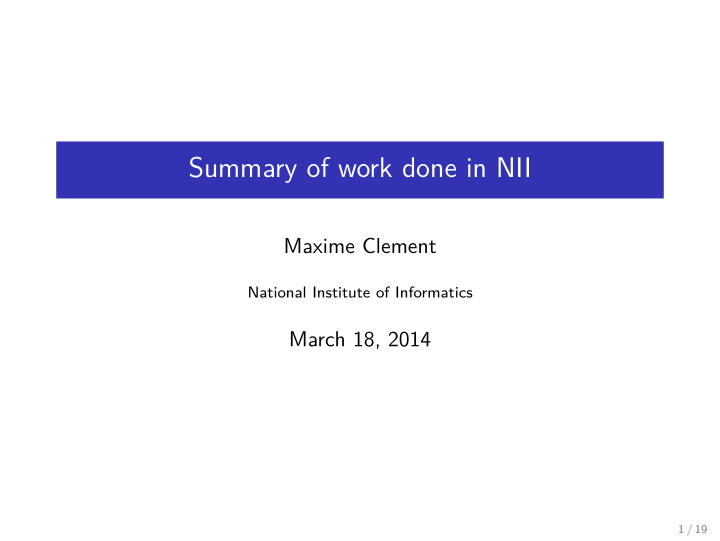



Summary of work done in NII Maxime Clement National Institute of Informatics March 18, 2014 1 / 19
History September 2011 - September 2013 : Master student (Paris 6). March 2013 - September 2013 : Internship student. January 2014 - April 2014 : Assistant professor. October 2014 - October 2017 : PhD student. 2 / 19
Summary 1 Main research topics Distributed Constraint Optimization Multi-Objective Dynamic 2 Past works 3 Current works Approximation algorithms for MO-DCOPs Dynamic DCOP 3 / 19
Distributed Constraint Optimization Problems Popular framework to model multi-agent coordination problems. Figure : distributed coordination problems 4 / 19
Distributed Constraint Optimization Problems Example of DCOP d j f ij ( d i , d j ) d i X1 0 0 1 0 1 2 1 0 2 1 1 0 X2 X3 X4 Figure : A mono-objective problem 5 / 19
Distributed Constraint Optimization Problems Example of DCOP d j f ij ( d i , d j ) d i 0 X1 0 0 1 0 1 2 1 0 2 1 1 0 1 X2 0 0 X3 X4 Figure : A mono-objective problem 6 / 19
Distributed Constraint Optimization Problems Example of DCOP d i d j f ij ( d i , d j ) 0 X1 0 0 1 0 1 2 2 1 0 2 1 1 0 X2 1 2 2 0 0 X3 X4 Figure : A mono-objective problem 7 / 19
Multi-objective case Several objectives to consider separately but to optimize simultaneously. 8 / 19
Multi-Objective DCOP Example of MODCOP d j f ij ( d i , d j ) d i X1 (1, 0) 0 0 (2, 1) 0 1 (2, 1) 1 0 (0, 2) 1 1 X2 X3 X4 Figure : A multi-objective problem 9 / 19
Multi-Objective DCOP Example of MODCOP d j f ij ( d i , d j ) d i Pareto front : (6,3) 0 X1 (1, 0) 0 0 (2, 1) 0 1 (2,1) (2, 1) 1 0 (0, 2) 1 1 1 X2 (2,1) (2,1) S ∗ = < { 0 , 1 , 0 , 0 } > 0 0 X3 X4 Figure : A multi-objective problem 10 / 19
Multi-Objective DCOP Example of MODCOP d j f ij ( d i , d j ) d i Pareto front : (6,3) 1 X1 (1, 0) 0 0 (0,6) (2, 1) 0 1 (0, 2) (2, 1) 1 0 (0, 2) 1 1 1 X2 (0, 2) (0, 2) S ∗ = < { 0 , 1 , 0 , 0 } , { 1 , 1 , 1 , 1 } > 1 1 X3 X4 Figure : A multi-objective problem 11 / 19
Multi-Objective DCOP Example of MODCOP d j f ij ( d i , d j ) d i Pareto front : (6,3) 0 X1 (1, 0) 0 0 (0,6) (2, 1) 0 1 (4,4) (2,1) (2, 1) 1 0 (0, 2) 1 1 1 X2 (0,2) (2,1) S ∗ = < { 0 , 1 , 0 , 0 } , { 1 , 1 , 1 , 1 } , { 0 , 1 , 1 , 0 } > 0 1 X3 X4 Figure : A multi-objective problem 12 / 19
Dynamic problems Many real-life problems are dynamic , they change at runtime. X1 X1 X1 X2 X2 X2 X3 X4 X3 X4 X4 Figure : Dynamic DCOP 13 / 19
Applications DCOP : Multi-agent coordination. Sensor networks. Meeting scheduling. MO-DCOP : Cybersecurity (privacy, cost, security). Dynamic DCOP : Dynamic environment. 14 / 19
Dynamic MO-DCOP Short paper at PRIMA 2013. Only the number of objectives changes. A problem in the sequence is known only once the previous one is solved (Reactive approach). Complete algorithm. Focusing on a change of objectives still make the problem hard to solve. 15 / 19
Dynamic MO-DCOP Submitted to ECAI 2014. Everything can change. Reactive approach. Consider decision change cost. Adjustable parameter to limit the new cost. Approximation algorithm. The new cost can be used to implement heuristics to find good solutions in a reduced runtime. 16 / 19
Approximation Algorithms for MO-DCOP The state of the art approximation algorithm : The Bounded Multi-Objective Max-Sum Algorithm ( B-MOMS ). Find a solution with a guarantee on its quality. Good quality for low density graphs. A complete MO-DCOP algorithm : The Two Phase algorithm (Medi and al, JAWS 2013). First phase uses local search to compute initial bounds on the solutions. The goal is to show that First phase is faster and gives better solutions than B-MOMS . 17 / 19
Dynamic-DCOP Uses Dynamic Programming. Compile changes that occurred to compute the new optimal solution. Should be very efficient for small changes. Can be used to design an approximation algorithm whose quality increases overtime until reaching exactness. 18 / 19
Merci ! I hope to be back soon. 19 / 19
Recommend
More recommend